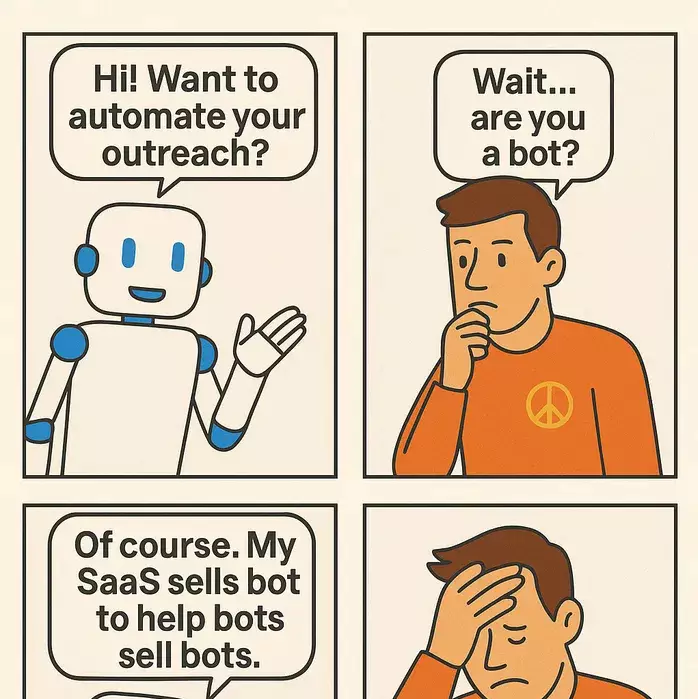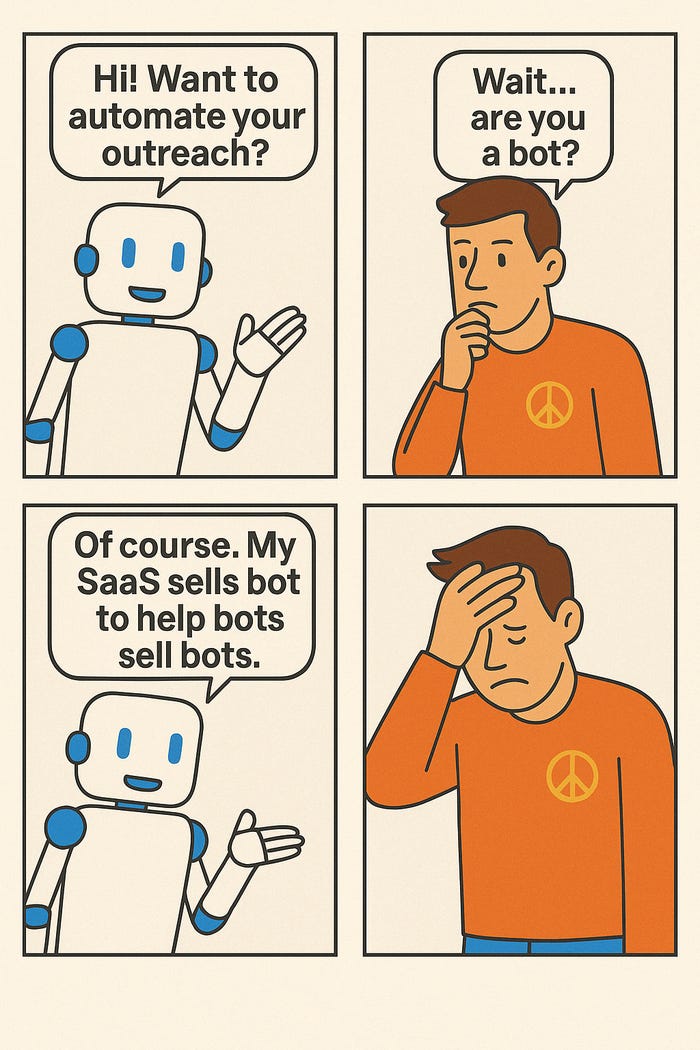In three decades the telecom stack lurched from monopoly break‑up to bot‑saturated marketing. The next disruption isn’t more automation; it’s old‑school human signal.
1 A Front‑Row Seat to 30 Years of Whiplash
I entered the industry in 1993, just as the commercial Internet escaped academia. I’ve since watched: the Telecommunications Act of 1996 detonate local monopolies; a 6,000‑strong startup Cambrian explosion; the dot‑com bubble’s $5 trillion vaporization; 9/11 and the long‑distance‑traffic shock; VoIP’s mainstreaming; and, more recently, the generative‑AI tsunami.
2 The ’96 Act: Deregulation, Disruption, and the Startup Gold Rush
The Act’s unbundling mandate let competitive local‑exchange carriers (CLECs) ride incumbent copper at wholesale rates. Between 1996–2000 the FCC granted over 6,000 CLEC licenses (FCC CLEC Competition Report, 2001). VC money flowed, and even moribund foreign PTTs felt pressure to liberalize. Then irrational exuberance met brutal economics: WorldCom’s $100 B market‑cap implosion (Wall Street Journal, 2002) and the 2000 telecom crash cut the field in half almost overnight.
3 Broadband, iPhone, and the Cloud Reset
Surviving carriers pivoted to DSL and cable broadband, seeding Skype (2003), AWS (2006), and the iPhone (2007). Cloud offloaded profitable application layers to hyperscalers, pressuring carriers to chase ever‑thinner connectivity margins and bet big on scale. Traffic exploded but margins shrank; scale became the only moat. Cue the mega‑mergers: AT&T + Time Warner/AOL, T‑Mobile ▸ Sprint, Verizon + Yahoo/HuffPost.
4 Regulation Reloaded: Capture by Any Other Name
Policy followed consolidation. TCPA (calls) and CAN‑SPAM (email) purported to protect consumers but mostly funded billable hours for incumbent legal teams. The 2017 repeal of net‑neutrality cemented pay‑to‑play bandwidth. Result: a two‑tier system—incumbents with lobbyists, and everyone else.
Lifeline Service, Dead‑Line Rules
Voice has always been a lifeline service: carriers were forbidden from arbitrary blocking. Yet since 2019, the FCC’s call‑blocking “safe harbor” lets mobile operators divert or label calls on metadata alone. I once watched a Verizon account‑manager call arrive on my AT&T handset tagged Spam Risk.
The Messaging Maze
Text messaging—bizarrely not classed as lifeline (the FCC excluded SMS from Title II common‑carrier obligations)—sits in an unregulated gray zone. Each carrier enforces its own application‑to‑person (A2P) playbook—10DLC, short code, toll‑free—often rewritten quarterly. It takes a spreadsheet just to keep fees straight. If Grandma has an emergency today she’ll probably text, not call, yet the regulatory logic is inverted.
Join Substack
5 The Attention‑Economy Stall‑Out
Algorithmic platforms colonized the eyeballs deregulation freed. Google Ads CPC for “SMS API” now clears $25; most SMBs are priced out. One‑third of U.S. adults already prefer ChatGPT to Google for search (Future Publishing survey, 2024). LinkedIn inboxes are a carnival of bots selling bots; tech firms are hiring on‑site again because résumés are LLM‑generated (The Pragmatic Engineer, 2025).
6 AI Boom, Bot Backfire—and the Scarcity of Trust
LLMs are brilliant assistants (this paragraph included), but the ROI of another automation drip campaign is collapsing. Harvard Business Review puts face‑to‑face asks at 34 × the conversion of email (van Epps & Nicholas, 2017). In other words, human bandwidth is suddenly scarce—and therefore valuable.
While much of this story is U.S.‑centric, Europe faces similar challenges: GDPR’s explicit‑consent requirements for marketing SMS have forced brands to rethink outreach strategies across the EU (EU GDPR FAQ).
7 Transparency Tech That Actually Helps
Some regulation does work. STIR/SHAKEN cut U.S. caller‑ID spoofing 29 % in its first year (FCC Robocall Report, 2023). And the voluntary Branded Caller ID (BCID) program, at roughly $0.05 per call, lifted answer rates 34 % for 78 SMBs over a six‑week pilot (CTIA White Paper, 2024)—cheap compared with a $25 click.
8 Signal Over Noise: The Playbook for 2025
Within 90 days, executives should:
- Enable STIR/SHAKEN + BCID on every outbound trunk.
- Cut automated cadence 25 %. Replace with two live dials or personalized Looms.
- Budget one in‑person trip per quarter for high‑intent prospects; refuse to “just Zoom.”
- Map your A2P channels—10DLC vs. toll‑free vs. short code—and pick one. Complexity is the hacker’s friend.
9 Conclusion: Authenticity Is the Next Network Effect
After thirty years oscillating between monopoly and mania, the telecom stack has become paradoxically simple: algorithms scream; humans whisper—and CFOs will notice the cost per qualified lead plummets when someone actually picks up the phone. The firms that win the next cycle will master both—deploying AI where it outperforms humans, but doubling down on scarce, high‑trust conversations when the stakes (or CAC) justify it. The phone call isn’t dead; it’s just waiting for someone to answer again.


